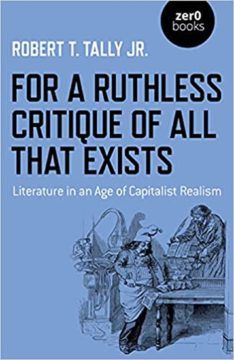 Robert Scott in the LA Review of Books:
Robert Scott in the LA Review of Books:
“IT IS EASIER to imagine the end of the world than it is to imagine the end of capitalism.” I feel ambivalent about this familiar saying, not because I disagree with it, but because it has been overused to the point of losing its force, its ability to help us grasp the devastating reality it describes. It has, in short, become a cliché, too catchy for its own good. Irritating too is the fact that the saying is nearly always quoted with reference to its apparently disputed attribution. Who came up with it first? Fredric Jameson? Slavoj Žižek? Mark Fisher? The simple — if rather boring — answer is that Jameson was paraphrased by Žižek, and then in turn both their expressions of the idea were synthesized by Fisher into the above pithy maxim describing his concept of “capitalist realism.” According to Fisher, capitalist realism is “the widespread sense that not only is capitalism the only viable political and economic system, but also that it is now impossible even to imagine a coherent alternative to it.” If we’re honest, the phrase’s source isn’t really a mystery. But worrying over its putatively enigmatic origins has given it the sheen of a proverb, reliable yet banal.
This trajectory from devastating truth to conventional wisdom may, however, encapsulate something essential to capitalist realism itself. It is apt, if tragically ironic, that the phrase that best describes what Robert Tally Jr. calls the “enervation of our imagination” of an alternative world (and ultimately of an alternative to the end of the world) should devolve into a stock phrase. In 1980, Christopher Ricks commented that “the feeling lately has been that we live in an unprecedented inescapability from clichés.” The maxim of capitalist realism — that “it is easier to imagine the end of the world than it is to imagine the end of capitalism” — both describes and has become an example of this depressing fact. Even the critique of capitalist realism risks being grasped by what it seeks to grasp: our seemingly ever-increasing inability to imagine something genuinely new or different, in spite of the apocalyptic threat posed by “all that exists.”
More here.

 W
W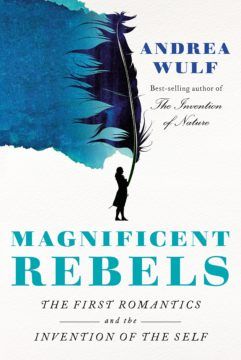 The grand title of Andrea Wulf’s new book is wonderfully sneaky — at least that’s how I chose to read it, considering that “Magnificent Rebels” happens to recount plenty of unmagnificent squabbling among a coterie of extremely fallible humans.
The grand title of Andrea Wulf’s new book is wonderfully sneaky — at least that’s how I chose to read it, considering that “Magnificent Rebels” happens to recount plenty of unmagnificent squabbling among a coterie of extremely fallible humans.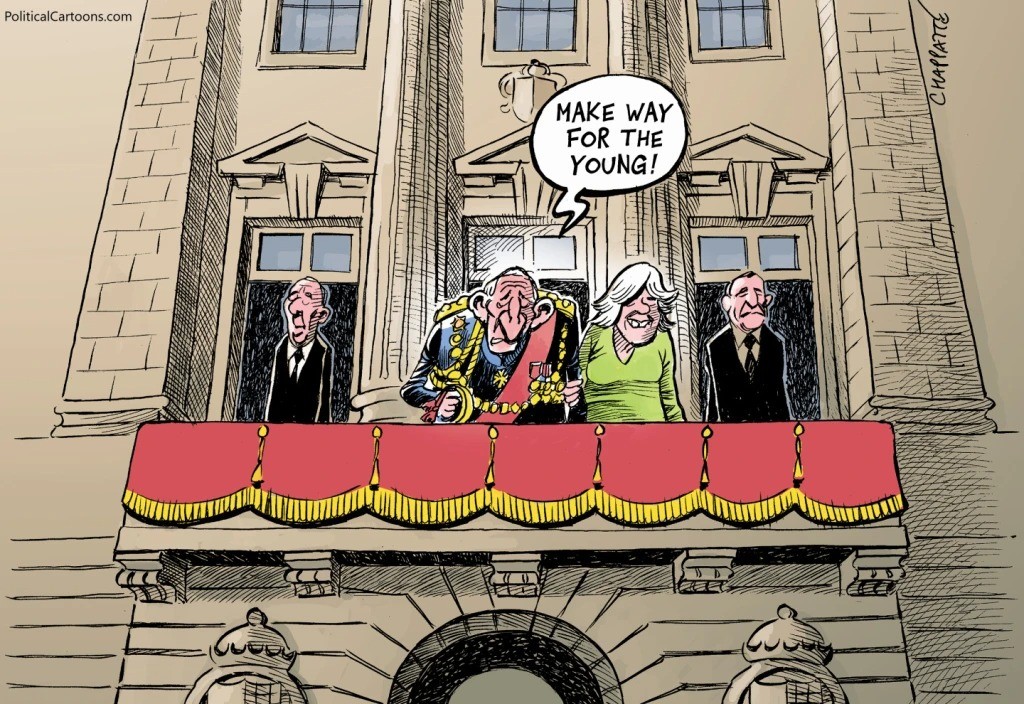
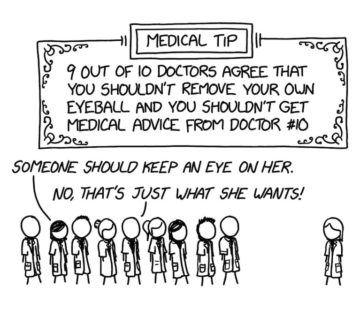 Several decades ago, it took a stand-up comedian like Steven Wright to work in shades of the brilliantly surreal when
Several decades ago, it took a stand-up comedian like Steven Wright to work in shades of the brilliantly surreal when  The idea of an “avant-garde” tends to inspire complex emotions, oscillating between excitement at its glamour and scorn at its pretensions. The term carries an association of being daring, experimental, unconventional; the main body of practice or opinion that it is in “advance” of is usually figured as a monolith of dull orthodoxy. But the label also easily attracts a lightly ironical coating, in which those so designated are held to be exhibiting an excess of self-consciousness or even self-congratulation, pluming themselves on innovations that others suspect are merely willful or modish. An avant-garde likes to present itself as insurgent and radical, yet the logic of the metaphor suggests that a new group will soon be coming along to replace it. Today’s avant-garde is always liable to congeal into tomorrow’s orthodoxy.
The idea of an “avant-garde” tends to inspire complex emotions, oscillating between excitement at its glamour and scorn at its pretensions. The term carries an association of being daring, experimental, unconventional; the main body of practice or opinion that it is in “advance” of is usually figured as a monolith of dull orthodoxy. But the label also easily attracts a lightly ironical coating, in which those so designated are held to be exhibiting an excess of self-consciousness or even self-congratulation, pluming themselves on innovations that others suspect are merely willful or modish. An avant-garde likes to present itself as insurgent and radical, yet the logic of the metaphor suggests that a new group will soon be coming along to replace it. Today’s avant-garde is always liable to congeal into tomorrow’s orthodoxy. As a medical entomologist who’s worked with mosquitoes for more than 40 years, I’m often asked why some people seem to be mosquito magnets while others are oblivious to these blood-feeding pests buzzing all around them.
As a medical entomologist who’s worked with mosquitoes for more than 40 years, I’m often asked why some people seem to be mosquito magnets while others are oblivious to these blood-feeding pests buzzing all around them. The Middle East was ahead of its time—and certainly ahead of the West—on at least one thing: existential debates over culture, identity, and religion. During the heady, sometimes frightening days of the Arab Spring, the region was struggling over some of the same questions Americans are contending with today. What does it mean to be a nation? What do citizens need to agree on in order to be or become a people? Must the “people” be united, or can they be divided?
The Middle East was ahead of its time—and certainly ahead of the West—on at least one thing: existential debates over culture, identity, and religion. During the heady, sometimes frightening days of the Arab Spring, the region was struggling over some of the same questions Americans are contending with today. What does it mean to be a nation? What do citizens need to agree on in order to be or become a people? Must the “people” be united, or can they be divided? In criticism as in war, the law of proportionate response enjoys only occasional observance.
In criticism as in war, the law of proportionate response enjoys only occasional observance.  If Guston was labeled an Abstract Expressionist for his nonobjective takes on Monet, Walker could fairly be described as an Abstract Romanticist for his nonobjective takes on John Constable, to whose paintings Walker was introduced as a child in Birmingham, England. In the catalogue, French describes his training at the Birmingham School of Art in the late 1950s as “rigorously traditional” and tells of the artist’s profound confusion upon discovering a Malevich canvas that impressed him by capturing all the emotion that he had experienced regarding Rembrandt’s Jewish Bride. Early on he realized that technique did not amount to feeling.
If Guston was labeled an Abstract Expressionist for his nonobjective takes on Monet, Walker could fairly be described as an Abstract Romanticist for his nonobjective takes on John Constable, to whose paintings Walker was introduced as a child in Birmingham, England. In the catalogue, French describes his training at the Birmingham School of Art in the late 1950s as “rigorously traditional” and tells of the artist’s profound confusion upon discovering a Malevich canvas that impressed him by capturing all the emotion that he had experienced regarding Rembrandt’s Jewish Bride. Early on he realized that technique did not amount to feeling.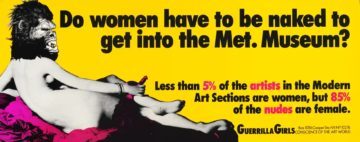 T
T Matthew Weiss dreams of the day when his oncology practice will operate very differently. A surgeon at the Northwell Health System in New York who treats pancreatic cancer—one of the deadliest malignancies known—he doesn’t have a lot of choices when it comes to saving his patients. Some people with pancreatic tumors die within a few weeks and others fight longer, but only
Matthew Weiss dreams of the day when his oncology practice will operate very differently. A surgeon at the Northwell Health System in New York who treats pancreatic cancer—one of the deadliest malignancies known—he doesn’t have a lot of choices when it comes to saving his patients. Some people with pancreatic tumors die within a few weeks and others fight longer, but only  Initial detractors called Minimalism “cold” and “inhuman,” and subsequent opponents deemed it “masculinist” and “totalitarian.” I still see these responses as emotionally reactive or formally reductive or both, and, like several other critics, I have stressed the phenomenological dimension of Minimalism, its engagement with the body and the space of the viewer, in part to counter such readings. Nonetheless, they did represent the sentiments of many observers, and some of these accounts also point to the historical problem at issue here, even if, to my mind, they misconstrue it in doing so.11 For what was taken as “inhuman” in Minimalist practice is better understood as “antihumanist,” a position that was largely shared by Conceptual artists. This antihumanism was active, for example, when, in another well-known conversation from 1966, Frank Stella and Donald Judd claimed to jettison European “rationalism,” and when Bochner insisted a year later that Conceptualists sought to bracket all considerations of style and metaphor.12 Not only a local reaction against late Abstract Expressionism, this rejection, widespread among artists, writers, and philosophers of the time, targeted a humanism that had had no effective answer for fascism, the Holocaust, or the Bomb and that continued to fail in the face of American imperialism in Southeast Asia and elsewhere.
Initial detractors called Minimalism “cold” and “inhuman,” and subsequent opponents deemed it “masculinist” and “totalitarian.” I still see these responses as emotionally reactive or formally reductive or both, and, like several other critics, I have stressed the phenomenological dimension of Minimalism, its engagement with the body and the space of the viewer, in part to counter such readings. Nonetheless, they did represent the sentiments of many observers, and some of these accounts also point to the historical problem at issue here, even if, to my mind, they misconstrue it in doing so.11 For what was taken as “inhuman” in Minimalist practice is better understood as “antihumanist,” a position that was largely shared by Conceptual artists. This antihumanism was active, for example, when, in another well-known conversation from 1966, Frank Stella and Donald Judd claimed to jettison European “rationalism,” and when Bochner insisted a year later that Conceptualists sought to bracket all considerations of style and metaphor.12 Not only a local reaction against late Abstract Expressionism, this rejection, widespread among artists, writers, and philosophers of the time, targeted a humanism that had had no effective answer for fascism, the Holocaust, or the Bomb and that continued to fail in the face of American imperialism in Southeast Asia and elsewhere.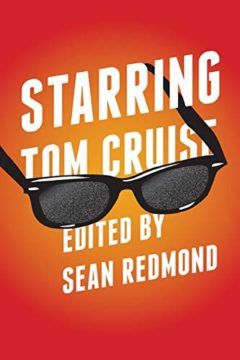 On my first viewing of Top Gun: Maverick, I was moved to tears. Many men who I’ve spoken to about the film have admitted to crying while they watched it. I cried, despite my awareness that I was being aggressively manipulated by a work of vainglorious, sentimental, and stupid propaganda for the US military. This is the only Cruise film which has moved me in this way. Between the aerial stunts, Top Gun: Maverick is a film about coming to terms with the death of the father: Cruise’s Maverick finds himself stuck in the complex situation of grieving for his peer, Iceman (Val Kilmer), who had become his surrogate father-protector, while simultaneously navigating his own role as a surrogate father-protector to Rooster (Miles Teller), the son of the man whose death he caused in the film’s prequel. Kilmer is only two years older than Cruise, but in Top Gun: Maverick he is coded as older and wiser, almost a mentor, due to his seniority in rank. Cruise/Maverick’s peers have aged around him, but he remains stuck in perpetual adolescence. This is a recent example of a long trend: Cruise’s filmography is filled with troubled relationships between absent or disappointing fathers and the sons who suffer. There is certainly scope for speculation about the influence the difficult relationship with his own father has had on the roles Cruise chooses and shapes.
On my first viewing of Top Gun: Maverick, I was moved to tears. Many men who I’ve spoken to about the film have admitted to crying while they watched it. I cried, despite my awareness that I was being aggressively manipulated by a work of vainglorious, sentimental, and stupid propaganda for the US military. This is the only Cruise film which has moved me in this way. Between the aerial stunts, Top Gun: Maverick is a film about coming to terms with the death of the father: Cruise’s Maverick finds himself stuck in the complex situation of grieving for his peer, Iceman (Val Kilmer), who had become his surrogate father-protector, while simultaneously navigating his own role as a surrogate father-protector to Rooster (Miles Teller), the son of the man whose death he caused in the film’s prequel. Kilmer is only two years older than Cruise, but in Top Gun: Maverick he is coded as older and wiser, almost a mentor, due to his seniority in rank. Cruise/Maverick’s peers have aged around him, but he remains stuck in perpetual adolescence. This is a recent example of a long trend: Cruise’s filmography is filled with troubled relationships between absent or disappointing fathers and the sons who suffer. There is certainly scope for speculation about the influence the difficult relationship with his own father has had on the roles Cruise chooses and shapes.